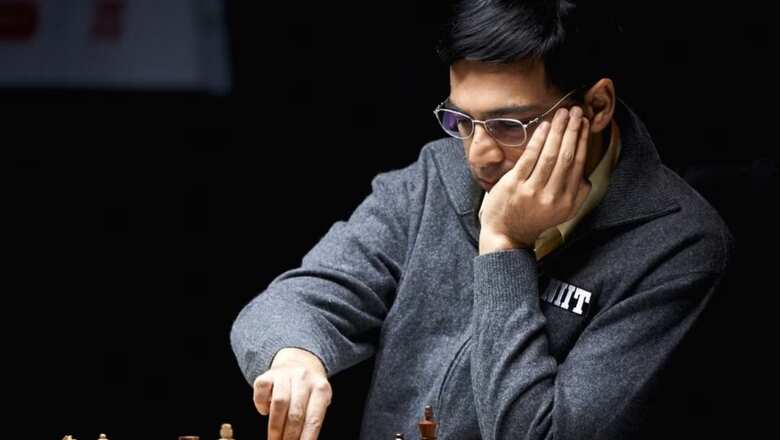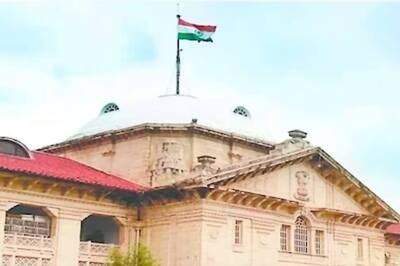
views
Remember, around the time Vikram lander was negotiating a soft landing on the far side of the moon as part of the Chandrayaan-3 lunar mission, India’s 18-year old Chess grandmaster, Rameshbabu Praggnanandhaa, was engaged in a tooth-and-nail fight on 64-square board with Norwegian Magnus Carlsen at FIDE World Cup in Baku, Azerbaijan in August 2023. While his victory, on the backdrop of a successful lunar landing mission, could have brought India double cheer, his finishing as the runner’s up hardly diminished his standing, given his young age and the fighting spirit he demonstrated against top-ranking Carlsen.
Recently, Praggnanandhaa’s sister Vaishali Rameshbabu also earned the title of grandmaster, at the 4th El Llobregat Open Chess Tournament in Spain. She thus became the third female chess player from India after Koneru Humpy and Harika Dronavilli to become a chess grandmaster (not to be confused with WGM or Women Grandmasters, for whom FIDE classical ratings and norm requirements are relatively relaxed, and whose numbers are not less than eight in India).
Praggnanandhaa and Vaishali have become the first brother-sister duo in India to earn the grandmaster title.
Until 2010, India had produced only 20 grandmasters; since then, India has added another 64 to the list. India has 84 chess grandmasters, at the time of writing this article. Recently, in a piece written in Hindustan Times, Vishwanathan Anand stated that India is at the cusp of a chess revolution. Even Magnus Carlsen stated earlier this year that India is at the start of the chess revolution, a process initiated by Vishwanathan Anand.
There is little doubt that advancement in Information Technology (IT), especially the advent of the Internet, has made research and preparations convenient for chess players. Garry Kasparov (2008) informs in his book (How Life Imitates Chess- Making the Right Moves from the Board to the Boardroom, P.23) that during his thirty years of professional chess, the world has gone from researching an opponent’s moves by digging through musty journals for days to pulling up every single game in his career in seconds on a personal computer. It used to take months for tournament games to be published in specialist magazines, but now anyone can watch games on the internet in real time.
Today’s IT-savvy youngsters are thus more advantageous in the matter of chess preparations than their predecessors a generation or two ago.
II
Chess coming of age in India is more than a story of a game. It is the story of a societal transformation. Munshi Premchand’s popular short story Shatranj Ke Khiladi (Premchand Rachnavali, Vol-13, and P.105-113) illustrates the negative reputation that the game of 32 pieces suffered from in the early 20th century. Whereas the story is framed in the backdrop of the annexation of Awadh (1856) by Lord Dalhousie, it appeared in its Hindi and Urdu versions in Madhuri and Zamana literary monthly magazines in 1924.
The story portrays two idle chess-playing aristocrats viz. Mirza Sajjad Ali and Mir Roshan Ali of Lucknow as epitomic of the pleasure-seeking and indulgent lifestyle of Awadh under the rule of Nawab Wajid Ali Shah. Their addiction to the game pushes Mirza Sajjad Ali and Mir Roshan Ali into the domain of irrationalism. They, in the end, take each other’s life, while Nawab Wajid Ali Shah is exiled to Calcutta by the British.
Satyajit Ray takes liberty with the original story in his classic film viz. Shatranj Ke Khiladi (1977), by ending the narrative with a rapprochement between the two noblemen, thus avoiding the gory tragedy on screen. His objective was actually to illustrate Lord Dalhousie’s policy of annexation, which he demonstratively likened to a game on the political chessboard of India.
III
Chess is believed to have evolved from Chaturanga, the four-armed game of chess dice, played in ancient India. Sir William Jones (1746-94), the British philologist and orientalist, was the first to draw the attention of the modern world towards this aspect. His essay, ‘On the Indian Game of Chess’, was published in the Asiatic Researches journal in 1790. Duncan Forbes (1798-1868) in his ‘History of Chess: From the time of the Early Invention of the Game in India till the period of its Establishment in Western and Central Europe’ (1860) traced the existence of the game Chaturanga in the Ramayana era.
The chroniclers of Arabia and Persia, informs Forbes, are unanimous on the following points viz- first, that the game of Chess, as known in the medieval ages, was invented in India, sometime previous to the sixth century of our era; and secondly, that the game was introduced from India into Persia during the reign of Kisra Naushirawan, the Chores of Byzantine historians, and contemporary of Justinian (History of Chess, P.37).
H.J.R. Murray in his ‘A History of Chess’ (1913) collated a number of references to Chaturanga in Sanskrit literature. They include works of Subandhu’s Vasavdatta and Bana’s Harshacharita etc. An early version of chess was called ashtapada (the eight-limbed). However, the game involved the casting of dice, as we have a reference in Harivamsa, of Rukmini playing against Balaram for a wager (P.35).
Islam deriving its knowledge of chess from Persia is undisputed, says Murray. The Arabic historians are unanimous that they learnt chess from the Persians. Shatranj, the Arabic name for chess, is derived from Persian chatrang (A History of Chess, P.186). An Islamised Persia not only transmitted the game into the Arabic sphere but also reintroduced the game in an improvised form in India in the medieval ages. Several Persian works on chess have been found in India.
Late Russian grandmaster Yuri Averbakh (1922-2022), the centenarian who passed away last year, tried to locate manuscripts on chess at the Salar Jung Museum in Hyderabad during his first visit to India in 1964. Though nothing came about, he resumed his search during his second visit to India in 1975. This time, apart from the manuscript of the already well-known Sadarnama (18th century), he discovered a previously unknown work on chess in Persian. The manuscript was only eight pages long, and divided into two parts, the first of which was datable to 958 Hijri (1551 AD). Averbakh later translated this manuscript in collaboration with Professor L Peysikov, a well-known expert in the field of Persian linguistics.
Averbakh reproduces an extract from the work in his concise book ‘A History of Chess: From Chaturanga to the Present Day’ (2012) with a Foreword by Garry Kasparov. A brief excerpt is given below; the dotted portions within brackets were undecipherable.
Only brave and wise men that have their own plan and knowledge, endurance, patience, resolve and determination, play chess. Stupid and ignorant people, especially those who are bitter and narrow-mined (…) cannot become chess players.
Rulers and scholars claim that they have learned how to rule because of chess, and so, it is beneath any Padishah not to know how to play chess. Indeed, you can find everything on the chessboard: an interesting concept, trickery and guile, determination and strategy, and without all of this, a king would be flawed (A History of Chess, P.73).
The idea that chess sharpens the mind and improves problem-solving skills survived in India, even when the game had actually become a pastime of idle men. Munshi Premchand acknowledges it, though himself mocking at the idea, apparently to meet the demand of his story’s plot.
IV
This Chaturanga, as distinguished from modern chess, was actually played by four persons with four sets of games, consisting of a king, an elephant, a horse and a boat (or chariot) and four pawns, and movement of those pieces were regulated by the throw of two cubic dice. It appears the board on which the game was played was called astapada (a board with 8×8 squares). This is affirmed by the discovery of Chaturanga-Dipika, a treatise by Sulapani, a 15th-century lawgiver (smriti-nidhandhakara) from Bengal. It was published under the Calcutta Sanskrit Series by Calcutta University in 1936.
Modern chess, in its format, rules and techniques, was developed in Europe. Chess, like Hindu numerals, was transmitted to Europe through Arabia and Persia. Yet, interestingly, chess is still called Chaturangam in Tamil (and approximately so in Kannada and Telugu). Tamil Nadu has emerged as the powerhouse of Indian chess, with 30 of the 84 grandmasters coming from the southern state alone. Maharashtra with 12 and West Bengal with 11 grandmasters lag miles behind it.
The popularity of chess in India is not a virtue (or vice) that could be attributed to British rule. Its craze was not transmitted to us, unlike the craze for outdoor games like football, cricket and hockey or even indoor club games like Contact Bridge. We could boast of India’s first football club Mohun Bagan (estd. 1889), the first Olympic hockey gold (1928), Indian cricket team under the captaincy of Maharaja of Porbandar touring England in 1932, but hardly any renowned chess players in pre-independent India.
This was despite the fact that Indians in the colonial era had been visiting London, which had become a hub of chess players, both British and foreign, around the middle of the 18th century. Foreign players like Francois-Andre Danican Philidor (1726-95) in the 18th century, Paul Morphy (1837-84) in the 19th, and Emanuel Lasker (1868-1941) in the 20th, spent significant part of their lives in London. As early as 1822, ‘Treatis on the Game of Chess: Containing a Regular System of Attack and Defence’ by J.H. Sarrat and W. Lewis came out from London. The distinction of holding the first international chess tournament (1851) went to London. It drew participation from 16 chess players.
Britain and France, in the 18th century, played a leading role in making chess the game of the middle class, whereas previously, in Italy, it was a preserve of the aristocracy. The cafes and clubhouses acted as venues for shaping this transformation. Despite its tag of a brainy game, not all British intellectuals were convinced of its cerebral value. H.G. Wells (1898) found it the most absorbing of occupations, but least satisfying of desires. “You have”, says Wells, “let us say, a promising politician, a rising artist, that you wish to destroy. Dagger and bomb are archaic, clumsy and unreliable- but teach him, inoculate him with Chess.” (Certain Personal Matters, P.210).
This reminds one of Albert Einstein (1952) who deplored that his compatriot and Chess genius Emanuel Lasker (a fellow German Jew), who had such a fundamental understanding of the theory of relativity, was restricted by a demanding obsession. Einstein, in contributing a Foreword to Dr. J. Hannak’s book ‘Emanuel Lasker: The Life of a Chess Master’ (1959) says, “Spinoza’s material life and economic independence were based on grinding of lenses; in Lasker’s life chess played a similar part. But Spinoza was luckier, for his business was such as to leave his mind free and independent; whereas master-chess grips its exponent, shackling the mind and brain, so that inner freedom and independence of even stronger character cannot remain unaffected”.
V
Whereas the modern avatar of chess might have reached India in the colonial era, it remained confined to British circles. Manuel Aaron (b.1935), India’s first international chess master, recalls that his grandfather, from whom he learnt the game, used to play chess with British judges, lawyers and officers etc. Chennai-based Aaron, who in his youth locked horns with the likes of Bobby Fischer, Mikhail Botvinnik etc credited Tamil Nadu as holding many chess tournaments since the 1940s, as helping the state become the chess hub. The beginnings, however, were very humble as he revealed in a video interview whereas there was little money with the chess federation.
The role of the erstwhile USSR in promoting chess in India could not be overlooked. Manuel Aaron himself learnt Russian, to have direct access to chess literature produced in that language. In 1972, he founded the famous Tal Chess Club (named after his chess icon Mikhail Tal) in Madras (now Chennai), which received grants from the USSR. A young Vishwanathan Anand is known to have frequented the Tal Chess Club and spent time playing the blitz version of the game. Though Aaron never coached Anand directly, he remembers the latter as a young boy, attending his free chess classes that were open to all. Anand used to ask many questions on chess theories, not all of which could be answered by Aaron.
Similarly, in 1976, Alekhine Chess Club (named after illustrious Russian grandmaster Alexander Alekhine) was set up inside Gorky Sadan, which housed the Russian Cultural Centre in Calcutta (now Kolkata). The Alekhine Chess Club helped foster the culture of chess in the “city of joy”. However, Dibyendu Barua, who was anticipated to become India’s first grandmaster in the early 1980s, but eventually conceded that honour to Vishwanathan Anand, was apparently not a product of it. A precocious Barua learnt the game from his father Binoy Barua.
Whereas India might be the mother of chess, she appreciably did not rest on her laurels. The concerted efforts made since the 1970s have borne fruit today as India is poised to become a chess superpower. A few years ago in 2016, grandmaster R.B. Ramesh, predicted that India could become the next Soviet Union in chess. Ramesh feels that India, as a young nation, enjoys the demographic advantage to throw up more chess players on the world scene. With more sponsorships, tournaments, and a favourable attitude of society, India might just be the next Chess superpower.
The writer is author of the book ‘The Microphone Men: How Orators Created a Modern India’ (2019) and an independent researcher based in New Delhi. Views expressed in the above piece are personal and solely that of the author. They do not necessarily reflect News18’s views.




















Comments
0 comment